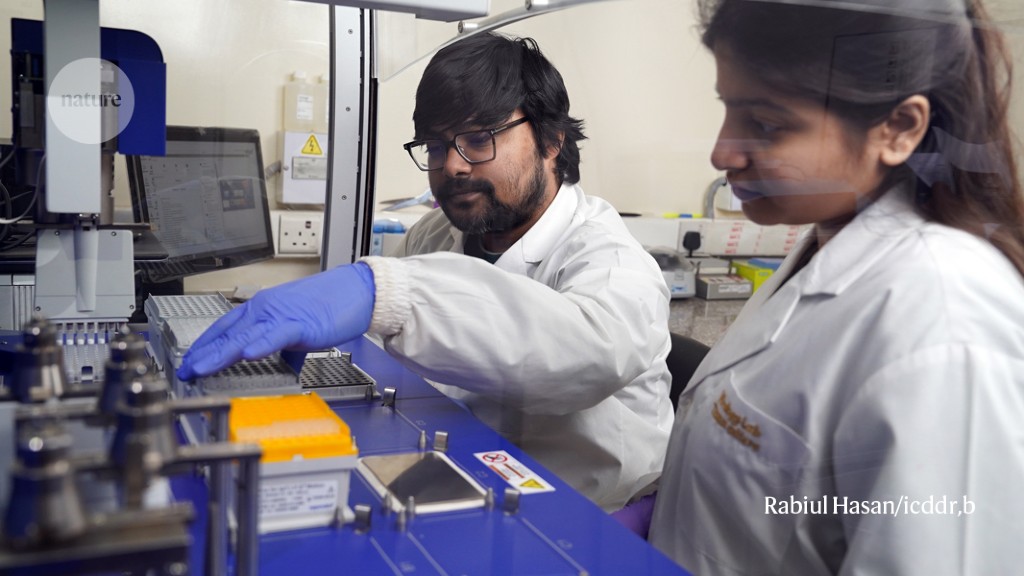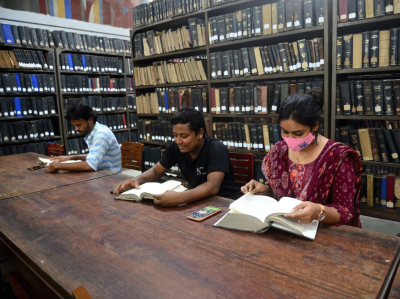Lower than 15% of the worldwide inhabitants lives in Europe or North America. But greater than 70% of revealed human microbiome information — on the collections of micro organism, fungi and viruses that reside on and in our our bodies — comes from European and North American populations1. Round 85% of the 25,000 high-resolution intestine metagenomes from youngsters beneath 4 which might be publicly obtainable come from people residing in these rich areas (see ‘Underneath-represented’). On this context, metagenomes are collections of all of the genomes contained in a faecal, pores and skin or different human pattern.
Likewise, investigators are starting to discover the microbiota as a therapeutic goal for varied ailments which might be frequent in high-income nations, corresponding to metabolic problems, most cancers and inflammatory bowel illness. A lot much less consideration is being given to how the microbiota impacts circumstances corresponding to malnutrition and infectious ailments that disproportionately have an effect on individuals residing in low- and middle-income nations (LMICs).
This should change. It’s now clear that the intestine microbiota — essentially the most studied of the human microbial communities — of youngsters and adults can differ markedly relying on the place individuals reside. So the event of protected and efficient microbiome-based therapeutics for these residing on the earth’s poorer areas is determined by microbiome information being collected from these areas.
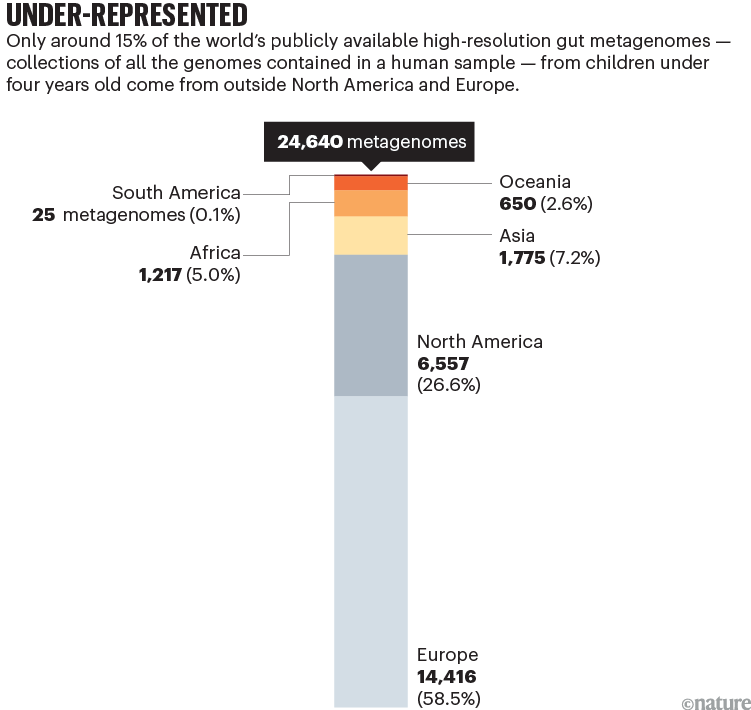
Sources: H. P. Browne et al.; information from NCBI/MGnify
To discover how microbiome analysis could possibly be accelerated globally, final 12 months, 4 of us (H.P.B., N.T.I, M.O. and C.T.) helped to prepare a two-day workshop on the Wellcome Genome Campus in Cambridge, UK. Funded by Wellcome Connecting Science and the Invoice & Melinda Gates Basis, this occasion — which all eight of us attended — introduced collectively leaders in early-life microbiome analysis in addition to early-career researchers from 23 nations.
All 39 of the researchers, funders and business representatives attending the occasion agreed that microbiome science has huge potential to enhance individuals’s well being globally — particularly the well being of youngsters. We additionally agreed that reaching this aim would require the gathering of knowledge from many various populations worldwide and the coaching of researchers in LMICs. It should additionally want the event of native infrastructure to analyse specimens and conduct medical research, and long-term collaborations involving researchers from LMICs, and from establishments and companies in Europe and North America — which presently lead microbiome analysis.
Good for well being
We’re born and not using a microbiota, however our our bodies are quickly colonized by various microbes — from our moms, the native atmosphere and different individuals in our social networks2,3. Sequencing research point out that in wholesome people, the human intestine microbiota develops in a definable manner, whereby the arrival of 1 species influences which species colonizes the intestine subsequent and so forth.
This ‘ecological succession’ begins at start with the switch of micro organism from the mom to the toddler throughout labour after which by means of skin-to-skin contact and br4eastfeeding. Some species of Bifidobacterium, for instance, are extremely tailored for colonizing the heart of infants as a result of they use carbohydrates present in mucus and breast milk. When an toddler stops breastfeeding, a few of these Bifidobacterium species primarily disappear, enabling different micro organism, corresponding to these within the spore-forming Lachnospiraceae household, to determine themselves.
In breaking down the carbohydrates within the intestine, Bifidobacterium species produce varied metabolites which might be useful to infants, corresponding to natural acids, B nutritional vitamins, neurotransmitters and proteins that modify the immune system4,5. Thus, the wholesome co-development of people and their intestine microbiota is essential to wholesome development. The truth is, there may be rising proof that disrupting the meeting of the intestine microbial group after start — whether or not by means of pathogen an infection or undernutrition — is linked to losing (through which a baby’s weight is low for his or her top) and stunting (through which a baby’s top is low for his or her age), in addition to different physiological circumstances6.
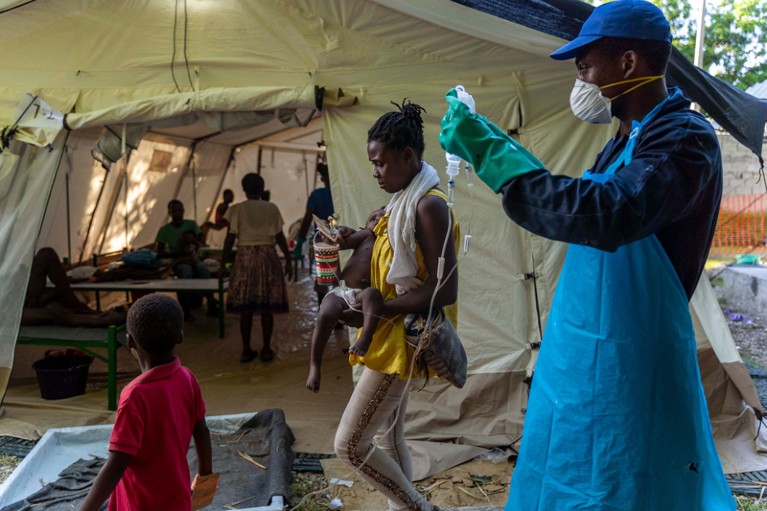
Peolple at a clinic in Cité Soleil, Port-au-Prince, obtain therapy for cholera.Credit score: Richard Pierrin/AFP/Getty
The microbiome-based therapeutics which might be presently being developed and examined in European and North American nations embody ‘subsequent technology’ probiotic formulations. Right here, investigators characterize what’s typical for a person after which work out whether or not an aberration in that individual’s microbiota is the trigger or impact of a given illness. They then establish therapeutic targets and develop microbiome-directed therapeutic candidates for testing in people.
However to complicate issues, the combination of microbes within the intestine and the capabilities of particular person species and subspecies change all through an individual’s life7. What’s extra, which explicit bacterial species (or subspecies) are current at anyone time varies relying on the place a person lives8. The Bifidobacterium longum subspecies infantis (B. infantis) that’s generally present in younger youngsters in Africa, for example, is essentially absent from the heart of youngsters residing in the US9.
Location issues
On the subject of LMICs, proof is now rising that the intestine microbiome might supply leads for therapeutics for a few of these nations’ greatest public-health threats.
Take undernutrition, which is related to practically half of all deaths of youngsters beneath 5 — 3.1 million yearly10. In research utilizing gnotobiotic mice (which have an outlined microbiota and are reared in sterile circumstances), researchers have in recent times recognized varied meals components that promoted the expansion of sure bacterial strains that had been under-represented in youngsters with malnutrition11,12. In subsequent medical trials, giving a gut-microbiota-directed meals formulation containing these components to malnourished youngsters aged 12–18 months in Bangladesh elevated the expansion of the kids. It additionally altered their microbiomes in order that they extra intently resembled these present in wholesome Bangladeshi youngsters13. A standard ready-to-use supplementary meals given to youngsters in the identical medical trial didn’t obtain the identical well being results, regardless of containing extra energy than the microbiota-guided meals components.
How our microbiome is formed by household, associates and even neighbours
Due to the genetic and phenotypic variety of individuals’s microbiomes, findings made in Europe and North America is not going to essentially apply to different areas — and coverings developed in rich nations may not assist individuals in poorer nations who may benefit from them essentially the most.
In a 2022 examine, for example, researchers gave Bangladeshi infants aged 2–6 months with extreme acute malnutrition a probiotic pressure that had been cultured from a donor in the US14. The infants within the examine had decrease ranges of B. infantis of their intestines than did wholesome infants from Bangladesh.
The probiotic improved the expansion charges of the malnourished infants and decreased irritation of their guts. However the ranges of colonization achieved within the examine had been 10- to 100-fold decrease than these present in wholesome infants14. On the premise of follow-up research in gnotobiotic mice, the researchers postulated that this mirrored the truth that the launched US-derived B. infantis pressure lacked sure genes which might be current in strains cultured from Bangladeshi infants. Infants in Bangladesh generally devour sure crops, and strains cultured from their guts include genes which might be concerned within the metabolism of the plant carbohydrates.
Such variation between nations is more likely to be necessary in different contexts, too.
In addition to serving to individuals to acquire sure vitamins, the intestinal microbiota protects them towards an infection by competing with pathogens for vitamins or by producing antimicrobial molecules that destroy them. Varied research have proven that in several settings, useful intestine microbes encounter completely different species and strains of pathogens15. So the intestine microbes present in communities residing in a single place may not have developed efficient methods to compete with pathogens which might be endemic elsewhere.
Likewise, the resistance of intestine pathogens to antibiotics varies with geography, relying partially on native well being procedures and rules round using antibiotics. And vaccines developed to guard individuals towards pathogens in a single space may not work so nicely in different areas. Take rotaviruses, some of the frequent causes of diarrhoeal illness amongst infants and younger youngsters. The rotavirus vaccine is as much as 90% efficient at stopping illness in high-income nations, however solely as much as 50–60% efficient in African and South Asian nations. This could possibly be due to completely different immune responses to the vaccine owing to completely different microbiota compositions in youngsters16.
Briefly, researchers attempting to develop therapeutics to deal with malnutrition or infectious ailments, might want to conduct research wherever the intervention shall be used.
A worldwide push
So, how can microbiome analysis be accelerated in LMICs?
At present, quite a few limitations are hampering progress. Researchers in LMICs usually lack the transport companies, freezers and dependable energy provides wanted to acquire samples and quickly freeze them at extraordinarily low temperatures (−80 °C or decrease). Freezing samples ensures the integrity of DNA and RNA for sequencing, and bacterial viability for culturing. LMICs usually lack the computational sources wanted to analyse and retailer huge information units. Additionally they don’t have entry to sealed anaerobic cupboards which might be required for culturing oxygen-intolerant intestine micro organism, archiving the classy organisms, sequencing their genomes and characterizing their development necessities and metabolic outputs. These nations additionally usually lack the amenities wanted to carry out research in gnotobiotic mice.
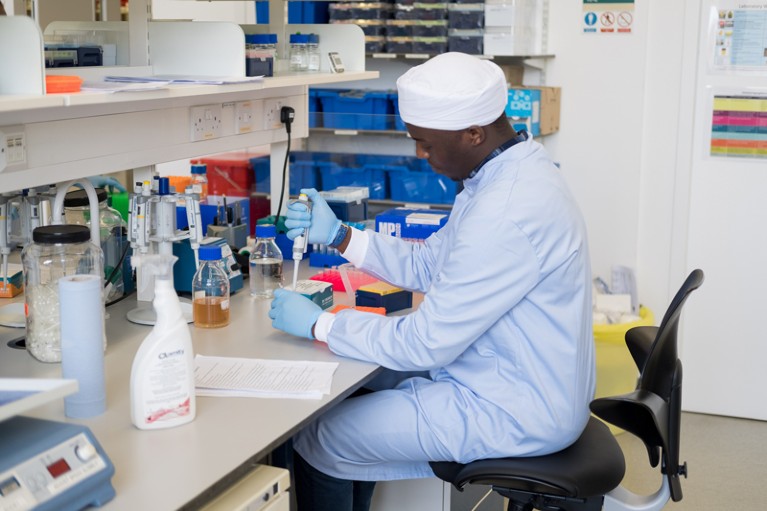
Microbiome analysis might assist to deal with some main public-health threats in LMICs.Credit score: Matthew Midgley/Wellcome Sanger Institute
Added to this are the comparatively excessive prices of reagents and the lengthy ready occasions to obtain them from producers owing to challenges round customs and provide chains. Maybe most significantly, in lots of LMICs, individuals lack the coaching and experience required to develop a multidisciplinary workforce that may conduct microbiome research.
Three steps, nevertheless, might raise many of those limitations.
Set up regional centres of excellence. At present, microbiome initiatives are inclined to take samples from donors for, at most, a 12 months or two. The institution of regional centres of excellence devoted to microbiome analysis would allow researchers in LMICs to conduct long-term sampling of the microbial ecology in a inhabitants (over a long time) — and to map and protect strain-level microbial variety. Such centres — which could possibly be funded by native governments in addition to by organizations corresponding to Wellcome and the Invoice & Melinda Gates Basis — might drive the coaching of researchers from different areas. These centres might additionally present a hub for sharing information, experience, insurance policies and procedures — because the African Centre of Excellence for Genomics of Infectious Illnesses based mostly at Redeemer’s College in Ede, Nigeria, does for infectious ailments.
The Cape City Assertion on equity, fairness and variety in analysis
Initially, these centres could possibly be established in universities or in analysis institutes that have already got some infrastructure in place, such because the Kenya Medical Analysis Institute in Nairobi, the Worldwide Centre for Diarrhoeal Illness Analysis in Dhaka, or the Aga Khan College in Karachi, Pakistan. However many different components ought to inform selections about the place to determine such centres — together with the impacts of malnutrition or infectious ailments, corresponding to cholera or typhoid fever, on a specific space, and the native governmental insurance policies that regulate sampling.
Develop microbial tradition collections. After acquiring knowledgeable consent from caregivers, together with for long-term use of the samples, researchers in LMICs want to determine curated microbial tradition collections — notably from youngsters.
A number of examples present steerage on how researchers can have interaction stakeholders, together with examine contributors. In 2015, for instance, researchers from the US and Peru, who needed to characterize the intestine microbiomes of Indigenous individuals in Peru, labored intently with native communities. Throughout this time, they reviewed examine procedures with group leaders, held public conferences for session, offered alternatives for group members to look at the scientists processing samples, and defined preliminary outcomes17.
By culturing particular person strains from a pattern, after which figuring out what genes every isolate carries, researchers might develop microbial reference genomes particular to the native inhabitants. By evaluating these genomes with these generated from different populations, scientists might then establish population-specific microbial variations, corresponding to these linked to weight-reduction plan or breastfeeding patterns. And by linking genomes again to cultured isolates and conducting experiments on them, the researchers might unpick the mechanisms underlying a specific adaptation. Excessive-quality reference genomes might even be used to enhance the taxonomic decision of metagenome profiling, through which researchers sequence thousands and thousands of quick stretches of DNA from a intestine pattern to evaluate what microbial species and subspecies are current18.
These curated tradition collections linked to high-quality reference genomes and metagenomes would offer a precious useful resource for microbiome analysis, and in the end pave the best way for the event of microbiome-based therapeutics.
Foster collaboration. Sturdy networks between the better-resourced tutorial laboratories in Europe and North America and researchers in LMICs shall be essential. Such collaborations ought to span a long time quite than a number of years — notably as a result of recruiting contributors for multi-year research, gathering and analysing the microbiome information and related metadata produced, after which validating the findings utilizing animal fashions and medical trials can take greater than ten years.
The workshop on the Wellcome Genome Campus linked researchers from varied nations with one another in addition to with funders. However moreover occasions of this type, change programmes and different initiatives might assist scientists from LMICs get the coaching they should grow to be leaders in microbiome analysis in their very own nations. Focusing on extra analysis grants to particular nations would assist assist trainees to proceed their analysis of their dwelling nations.
Efforts to make sure that genomic information and evaluation instruments are shared and used pretty amongst all collaborators have elevated prior to now few years. We welcome this. But, worldwide laws such because the 2010 Nagoya Protocol, which strives to make sure equitable entry to genetic sources, can — in our expertise — make it more durable for scientists working in LMICs to interact in worldwide collaborations19.
Some nations which have adopted the Nagoya Protocol fail to offer researchers with steerage on what steps to absorb apply. Additionally, working with attorneys to attract up agreements for the switch of supplies from one nation to a different can take months and price 1000’s of {dollars}. Going ahead, extra clear, standardized and environment friendly, however ethically grounded, procedures are required.
Advantages for all
As long as microbiome-based therapeutics are designed, manufactured and delivered by organizations exterior LMICs, lots of the financial and societal advantages ensuing from these remedies in all probability received’t attain the communities that want them most. Conversely, a greater understanding of the composition, capabilities and evolutionary forces at play in individuals’s intestine and different microbiotas — from various settings — might enhance long-term well being outcomes for everybody.

